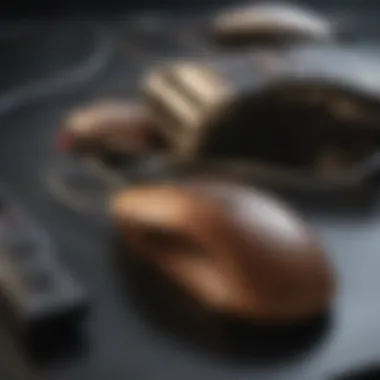Effective Electrical Devices to Deter Mice


Intro
Mice have become a common nuisance in many households. Their presence not only raises concerns about hygiene but also poses risks to property. Understanding how to effectively deter these pests without relying on harmful chemicals is crucial for many homeowners.
This article offers insights into the use of electrical devices as a practical solution to keep mice at bay. We will explore various types of devices, their effectiveness, and the principles behind their operation. The goal is to arm homeowners with knowledge to tackle this problem effectively while ensuring safety and sustainability in pest management.
Understanding Pests
Definition of Pests
Pests are organisms that disrupt human activities or health. In the context of households, pests include rodents, insects, and other animals that invade spaces and can cause damage or health risks. Mice specifically are known for their ability to breed rapidly and invade homes in search of food and shelter.
Importance of Pest Identification
Identifying pests accurately is essential for effective management. Mice can often be mistaken for other rodents, leading to ineffective control measures. Understanding their habits and behaviors helps in choosing appropriate deterrents. This awareness supports targeted actions, which can lead to reduced infestation rates and lower risk of property damage.
Prevention Techniques
Home and Garden Preventative Measures
Effective prevention begins with maintaining a clean environment. Here are several techniques:
- Seal Entry Points: Mice can squeeze through very small spaces. Inspect walls, foundations, and around utility openings.
- Store Food Properly: Keep food in airtight containers. This reduces the allure of your home for mice.
- Manage Waste: Dispose of garbage regularly and ensure bins are sealed.
- Landscape Carefully: Trim bushes and trees away from the home to limit nesting sites.
Seasonal Prevention Tips
Different seasons bring varying risks of mouse infestations. Consider these tips for seasonal effectiveness:
- Autumn Preparations: In the fall, check for cracks and gaps that may allow mice to enter as temperatures drop.
- Winter Vigilance: Ensure HVAC vents and pipelines are secure to prevent entry during colder months.
- Spring Clean-up: Remove debris from yards and garages where mice might nest.
Eco-Friendly Pest Control Solutions
Overview of Sustainable Practices
Many homeowners now prefer ecological approaches to pest control. This includes non-toxic deterrents, which are safer for both pets and children. Examples of such practices include using electronic devices which emit sounds unpleasant to mice.
Natural Remedies and Their Effectiveness
Natural remedies can also complement electrical devices. Although their results might vary, here are some noted methods:
- Peppermint Oil: The strong scent is said to deter mice. Soaking cotton balls and placing them in entry points may help.
- Ultrasonic Devices: These devices emit high-frequency sound waves that are uncomfortable for mice but mostly inaudible to humans.
Finale
Electrical devices present a promising method for deterring mice effectively. When combined with practical preventive measures and sustainable practices, homeowners can create an environment that is not only mouse-resistant but also safe and healthy. Understanding these methods enhances proactive pest management.
Foreword to Mice Infestation
Mice infestation presents significant problems in residential areas. Understanding this issue is critical for homeowners. Mice are not only a nuisance; they can also compromise health and safety. This article discusses the various effective electrical solutions to deter mice. By addressing the problem of mice, homeowners can safeguard their living spaces against potential damage and disease.
The presence of mice in homes can lead to various complications, from structural damage to food contamination. The financial implications of a thorough infestation can be substantial. Therefore, knowing how to handle mice immediately is essential.
The Problem of Mice in Residential Areas
In residential areas, the increasing population of mice has become prevalent. The urban environment provides ample food and shelter for these pests. Mice are agile and clever animals, capable of entering the smallest openings in buildings. They reproduce quickly, resulting in rapid population growth if not addressed.
The consequences of mice in homes can be serious. They can chew through electrical wires, which poses fire hazards. Mice also carry diseases such as hantavirus and leptospirosis, threatening the health of inhabitants. The primary reason people seek deter mice methods is to restore peace of mind. Addressing a mouse infestation early can prevent larger issues in the future.
Understanding Mice Behavior


To effectively deter mice, it is essential to understand their behavior. Mice are nocturnal creatures, often active when humans are asleep. This makes detecting their presence challenging. They are naturally curious and can easily explore environments for food.
Mice are known to mark their territory with urine and droppings. Recognizing these signs is key for homeowners. They tend to travel along walls and avoid open spaces. Understanding these habits can guide decisions on placing deterrents effectively. Mice also prefer areas that offer shelter, such as cluttered spaces or behind appliances. Knowing their tendencies to hide helps in strategizing the placement of electrical devices designed to repel them.
By grasping the fundamentals of mice behavior, homeowners can effectively target their solutions. With this knowledge, it becomes easier to implement practical and effective solutions to deter mice.
Technical Overview of Electrical Devices
Understanding the technical aspects of electrical devices designed to deter mice is crucial for homeowners. These devices use various technologies to combat pests effectively. An effective technical overview will provide insights into how these devices operate and why they are considered viable solutions for pest control.
When considering the use of electrical devices for rodent control, it is important to evaluate their components, functionalities, and potential benefits. Homeowners will benefit from comprehending the efficacy and limitations of each type of device, ensuring informed choices are made for their specific circumstances.
Moreover, understanding these devices sheds light on their adaptability to different home environments. Specific considerations, such as energy consumption, maintenance requirements, and environmental impacts, must also be taken into account. This knowledge allows for strategic selection of devices that not only address the current infestation but also serve as a long-term solution.
Types of Devices Available
There is a variety of electrical devices designed for mouse determent, each employing different methods. Here are some common types:
- Ultrasonic Repellents: These devices emit high-frequency sounds that are inaudible to humans but disruptive to mice.
- Electric Traps: These traps utilize electrical currents to efficiently kill mice upon contact.
- Nightlight Repellents: Bright lights are activated at night to create an unwelcoming environment for mice.
Each type of device comes with its own set of strengths and weaknesses. Ultrasonic repellents are popular for being easy to use and non-lethal, while electric traps offer a more direct approach. Understanding the sought-after outcomes will help homeowners choose the right tool for their needs.
How These Devices Work
The functionalities of these electrical devices differ based on their design and technology. Here is how they typically operate:
- Ultrasonic Repellents: These devices work by emitting sound waves at frequencies that disrupt rodent communication and navigation. Continuous exposure is meant to drive pests away from the vicinity.
- Electric Traps: They contain metal plates that deliver a lethal shock when a mouse completes the circuit. This mechanism ensures a quick death, minimizing suffering. These devices are discreet and can be used in sensitive areas.
- Nightlight Repellents: These devices combine light and sometimes sound to create an environment that mimics natural threats, making rodents less likely to invade.
Understanding these mechanisms helps homeowners realize the appropriateness of each device in various settings. Simplicity of operation is also a key advantage, as many of these devices are plug-and-play, making it easy for anyone to set up efficiently.
"Investing in electrical devices for pest control is not just about immediate results, but also about establishing a preventative approach to future infestations."
In summary, having a technical overview of electrical devices not only enhances the understanding of their purpose but also guides effective decision-making regarding pest control solutions.
Ultrasonic Repellents
Ultrasonic repellents serve as an intriguing solution in the ongoing battle against mice infestations. These devices aim to deter rodents without the use of harmful chemicals or traps, making them appealing to those who prefer a less aggressive approach to pest control. The ability to repel mice using sound waves offers homeowners a sense of security while also minimizing environmental impact. This section dives into the technology behind ultrasonic repellents, evaluates their effectiveness, and discusses their limitations, providing a detailed overview essential for informed decisions in pest management.
Defining Ultrasonic Technology
Ultrasonic technology utilizes sound waves at frequencies higher than the audible range for humans. Specifically, these sound waves typically operate between 20 kHz and 65 kHz. Mice and other rodents can hear these frequencies, while humans cannot. The devices generate these high-frequency sounds to create an uncomfortable environment for rodents.
These repellents are available in various forms, from plug-in units to battery-operated devices. The sound waves emitted disrupt the rodents' normal activities, causing stress and discomfort. As a non-lethal method, ultrasonic repellents offer an alternative to traditional pest control strategies, which often rely on traps or poisons.
Efficacy of Ultrasonic Repellents
The effectiveness of ultrasonic repellents has been a subject of debate. Some studies claim they can significantly reduce rodent activity in a specific area. Homeowners often report positive experiences, noting reduced sightings of mice shortly after installation. The sound emitted is believed to interfere with the animal's communication and navigation, disrupting their behavior.
However, results can vary depending on several factors, such as:
- Placement of device: Optimal positioning enhances effectiveness.
- Room layout: Sound waves can be obstructed by furniture and walls.
- Type of rodent: Different species may react differently to ultrasonic sounds.
While many users claim success, it's essential to approach these claims with caution. Understanding the nuances and conditions affecting efficacy is crucial for homeowners seeking reliable pest control methods.
Limitations of Ultrasonic Devices
Despite the benefits, ultrasonic repellents are not without limitations. Critics point out several concerns, which include:
- Variable effectiveness: As mentioned earlier, efficacy may differ based on environmental factors and rodent species.
- Temporary solution: Over time, rodents may become accustomed to the sound, reducing its effectiveness.
- Limited range: The sound waves do not travel well through solid objects, which can limit coverage area.
- No impact on other pests: While intended for mice, these devices do not deter all types of pests, such as insects.


It is essential for homeowners to recognize that ultrasonic repellents should be used as part of a broader pest management strategy. Combining these devices with traditional traps, bait strategies, and preventive measures can improve overall effectiveness.
Using ultrasonic repellents may help reduce rodent activity, but they rarely eliminate the problem entirely. Understanding their limitations ensures realistic expectations.
By comprehensively examining ultrasonic technology and its role in pest management, homeowners can better appreciate where this solution fits within their overall strategy to deter mice.
Electric Traps
Using electric traps for rodent control presents an effective means of addressing mouse infestations. These devices operate by delivering a swift, lethal electric shock to the mouse. They offer several benefits that make them appealing for homeowners seeking humane and efficient solutions. Electric traps not only eliminate mice quickly but also minimize potential mess compared to traditional methods like snap traps.
One of the distinct advantages of electric traps is that they often incorporate indicators that signal a catch. This feature allows users to monitor the device’s effectiveness without needing to frequently check the trap. Additionally, many electric traps are designed to be reusable, making them cost-effective over the long term. Their compact design also allows for discreet placement throughout the home, which can help to keep the vicinity clear of clutter and minimize the chance of future infestations.
Understanding Electric Traps
Electric traps are devices that provide a controlled electric shock to mice to ensure rapid death. These devices are often powered by batteries or can be plugged into an outlet. When a mouse enters the trap, it walks onto metal plates that complete the electrical circuit, delivering a high-voltage shock. This method is designed to be humane, as it typically results in the quick death of the animal.
Some products also come equipped with features such as sensors that activate the trap when a mouse enters. This ensures that the device only operates when needed, prolonging battery life and improving efficiency.
The design of electric traps varies, with some featuring enclosed chambers to prevent the escape of other animals and also to conceal any remains, thereby making trapping less visually unappealing to humans.
Placement Strategies for Maximum Effectiveness
Proper placement of electric traps is crucial for achieving optimal results. Here are some strategies that caregivers can implement:
- Identify High Traffic Areas: Position traps along walls, in corners, and near food sources where mice are likely to travel. Observing droppings can also guide placement.
- Avoid Open Spaces: Mice tend to avoid wide open areas. Traps placed directly in their paths will often go disregarded. Ensuring traps are near cover can lure more mice in.
- Elevate Traps When Necessary: In cases where mice are known to climb, placing traps high on shelves can enhance success rates.
- Monitor and Adjust: After placing traps, it is wise to monitor them for activity regularly. If catches are low, consider adjusting locations according to observed movement patterns.
By strategically placing electric traps, homeowners can significantly increase their chances of effectively deterring and eliminating mouse populations from their homes.
Nightlight Repellents
Nightlight repellents offer a unique approach to deter mice effectively. These devices use light and sound to create an environment that is less inviting for mice while simultaneously serving as a functional nightlight for the household. The incorporation of these dual-function devices can be an important aspect for homeowners seeking practical solutions against mice without the complications of traps or poisons.
Concept and Mechanism
Nightlight repellents operate by utilizing specific wavelengths of light that disrupt the natural behavior of mice. The theory is that the presence of continuous light causes discomfort to the nocturnal habits of these pests.
In addition, many nightlight repellents also emit a range of ultrasonic frequencies that are designed to be inaudible to humans but irritating to rodents. The combination of both light and sound creates an unwelcoming environment. It may confuse or repel mice, encouraging them to avoid the area altogether. This dual mechanism enhances their effectiveness, making them a viable option for homeowners looking to keep mice at bay without aggressive measures.
User Experiences and Feedback
Feedback from users of nightlight repellents tends to be mixed, with some enthusiasts swearing by their effectiveness, while others report minimal results.
Positive experiences often highlight the convenience of having a solution that doubles as a nightlight. Many homeowners appreciate the ability to maintain a well-lit area while working against pest problems. Some users have observed a decline in mouse activity over time after installing these nightlight devices in specific areas of their home.
On the flip side, there are reported cases where individuals found that the devices did not produce significant changes in rodent activity. Some users recommend placing multiple units in strategic locations to enhance the overall effectiveness of the repellents.
Ultimately, while nightlight repellents may not work for everyone, they can provide an additional layer of defense in a comprehensive pest control strategy. Of course, combining these devices with other measures—like traps and sealing entry points—can increase overall success in managing mice infiltration.
Safety Considerations
Ensuring safety when using electrical devices to deter mice is crucial. It involves an understanding of potential risks and implementing necessary precautions. This section sheds light on important aspects of safety related to electrical pest control devices.
Assessing Risks with Electrical Devices
When considering the use of electrical devices for deterring mice, it is essential to evaluate potential hazards. Most devices are designed with safety features, but users must remain vigilant. Common risks include electrical shock, device malfunction, and fire hazards.
It's advisable to always follow the manufacturer's instructions to reduce risks associated with electrical devices.
Another consideration is the placement of these devices. They should be positioned where they cannot be easily accessed by children or pets. Ensuring that cords are not frayed or exposed is also significant to prevent accidents. Regular inspections of devices will help in identifying any deficiencies early, enabling timely repairs or replacements.


Child and Pet Safety Concerns
Protecting children and pets is paramount when using electrical deter devices. Many families worry about the possible dangers these devices pose. Most electric traps and other electrical pest control methods are designed with safety in mind. However, it's necessary to be proactive. Ensuring that these devices are placed out of reach is an effective strategy. Keep them in areas where curious hands or paws cannot reach.
Sometimes, the sounds generated by ultrasonic repellents can disturb pets. Some dogs and cats might react negatively to these sounds. Understanding how your pet responds is essential. If a device seems to upset them, consider alternative methods or consult with a veterinarian for guidance.
In summary,
- Evaluate the electrical devices before use.
- Always follow safety instructions.
- Regularly inspect devices to ensure proper functioning.
- Keep devices out of reach of children and pets.
- Monitor your pets' reactions and make adjustments if necessary.
Integration with Other Pest Management Strategies
Using electrical devices to deter mice is an effective component of a comprehensive pest management plan. However, to maximize results, it’s essential to integrate these devices with other methods. This synergy creates a more robust defense against infestations, addressing not just the immediate presence of mice but also their potential re-entry.
Combining Devices with Traps and Baits
When electrical devices are used in conjunction with traditional traps and baits, it enhances effectiveness. For instance, ultrasonic repellents can be installed in various rooms. They disrupt the auditory environment that mice rely upon while they navigate and communicate. Electric traps can be strategically placed near areas where mice might enter, directly addressing the problem of those that get through.
Using baits alongside traps can attract mice even in presence of repellent devices. Placing bait stations in corners or along walls, paired with traps, creates an effective two-pronged approach. It is important to ensure that all components are checked regularly. This prevents accumulation of rodents and maintains cleanliness in the household.
Preventive Measures to Enhance Effectiveness
To get the most out of electrical devices and traps, several preventive measures should be adopted. Keeping the home clean is crucial, as crumbs and food left out can attract mice regardless of the deterrents. Ensuring that all food items are stored in hard, sealed containers can prevent unnecessary attraction.
Another crucial measure involves identifying and sealing potential entry points, such as small holes or gaps in walls, windows, and doors. Mice can squeeze through surprisingly small spaces, so a thorough evaluation of the home structure is necessary. Homeowners should also consider regular inspections of the exterior.
"Prevention is often more effective than reaction. A proactive approach can fundamentally reduce the risk of infestations."
Moreover, maintaining the perimeter around the house can deter mice. Keeping vegetation trimmed and avoiding wood piles close to the home minimizes hiding spots that might prompt mice to move closer to residing spaces.
Evaluating Long-term Solutions
In the pursuit of maintaining a mouse-free environment, evaluating long-term solutions is a crucial component in any pest management strategy. Using electrical devices to deter mice can be effective, especially in residential areas. However, understanding their long-term implications, costs, and reliability is key for homeowners seeking permanent resolutions. This section aims to shed light on the specifics of long-term effectiveness, ensuring that any approach taken today yields results for tomorrow.
Cost-Effectiveness of Electrical Devices
When choosing an electrical device for pest control, cost-effectiveness should be at the forefront of decision-making. Initial costs can vary widely depending on the type and technology of the device. For instance, ultrasonic repellents are generally cheaper than electric traps but may have varying rates of success. Homeowners should carefully assess the following points:
- Initial Investment vs Long-term Benefit: While a high-quality electric trap might cost more upfront, its ability to provide sustained results can offset the initial expense over time.
- Maintenance Costs: Some devices may require replacement parts or batteries, which can add to ongoing expenses. Assessing the long-term maintenance costs is just as important as evaluating the initial price.
- Impact on Property Value: Effective pest control can enhance the property value, making even slightly more expensive solutions worthwhile.
"Investing in long-term pest control solutions ultimately saves money and ensures peace of mind in keeping your home secure from infestations."
Assessment of Device Longevity
The longevity of electrical devices is another important consideration for homeowners. Different devices have varying lifespans influenced by factors such as usage, quality, and environmental conditions. Here are elements to consider:
- Warranty Information: Most reputable companies offer warranties on their products. Understanding the warranty can give an indication of the manufacturer's confidence in the device's durability.
- Build Quality: Devices made from durable materials often last longer. Investing in a well-constructed product can yield better long-term outcomes.
- Usage Patterns: How often and in what conditions the device is used will greatly affect its lifespan. For example, an electric trap used in a high-traffic area may wear out faster than one in a seldom-used space.
- Technological Advances: The field of pest control technology is rapidly evolving. Devices that were once cutting-edge may become outdated or less reliable over time. Evaluating whether a newer model or technology is available can help ensure optimal performance.
In summary, assessing both the cost-effectiveness and longevity of electrical devices is essential for anyone serious about long-term pest control solutions. Taking these factors into account can lead to a well-rounded approach that ensures ongoing protection from mice infestations.
Culmination
In examining the effectiveness of electrical devices for deterring mice, it becomes apparent that these solutions offer a practical alternative to traditional methods. The importance of this conclusion lies in recognizing that electrical devices can be part of a comprehensive pest management strategy. By focusing on their principles of operation, we can ascertain their efficacy and the safety measures necessary for implementation in a household setting.
Summary of Key Points
A concise recap of the principal discussions includes:
- Types of Devices: Various electrical devices range from ultrasonic repellents to electric traps. Each serves a unique purpose and is designed to handle specific infestation challenges.
- Functionality Insights: Understanding how these devices work helps homeowners make informed choices.
- Safety Considerations: Evaluating child and pet safety is crucial, ensuring that the use of these devices does not inadvertently introduce new risks into the home.
- Long-term Efficacy: Weighed against cost considerations, the longevity and effectiveness of these devices can prove advantageous for optimal pest control.
Final Recommendations for Homeowners
For homeowners seeking solutions to mice problems, several recommendations can enhance pest management efforts:
- Evaluate Your Needs: Assess the level of infestation and determine which electrical device or combination of devices suits your needs.
- Integrate with Other Strategies: Consider using electrical devices in tandem with traps and preventive measures to create a more fortified environment against mice.
- Regular Maintenance: Keep devices clean and functional to ensure they operate effectively over time.
- Stay Informed: Continuously review new advancements in electrical pest deterrence technology and stay updated on user feedback and experiences to select the best options available.
Researching and applying these recommendations can lead to a harmonious and mice-free living space. By integrating electrical devices into a broader pest management approach, homeowners can foster a safe and comfortable environment while minimizing reliance on chemicals.



